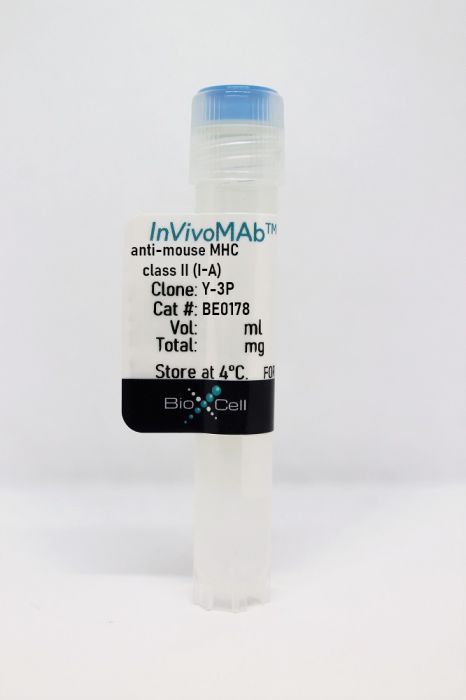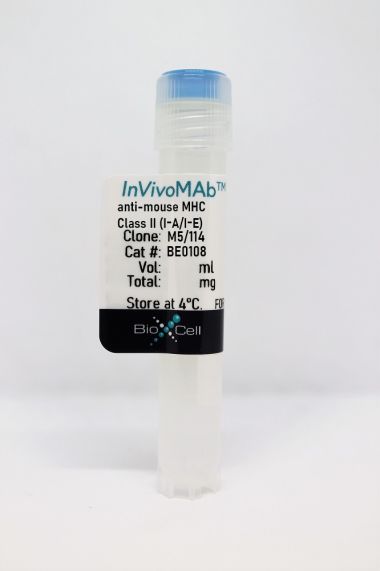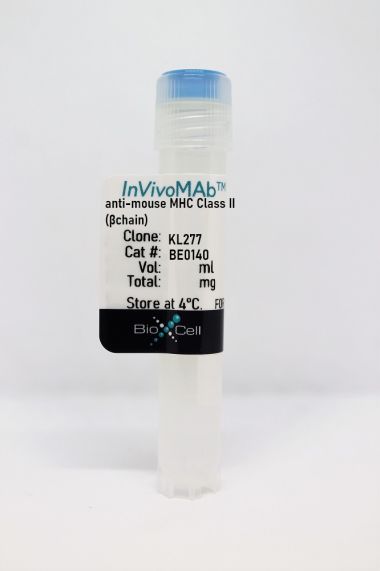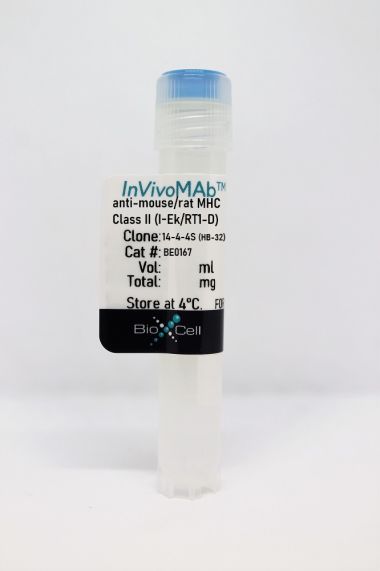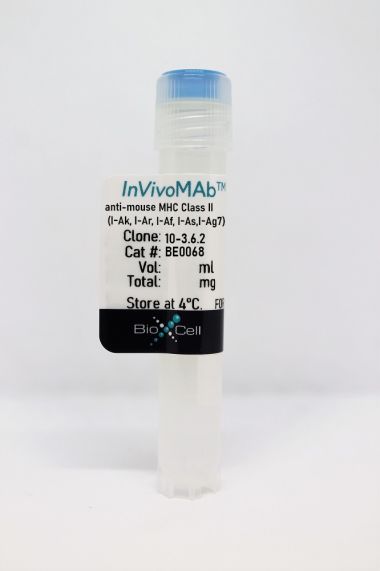InVivoMAb anti-mouse MHC class II (I-A)
Product Details
The Y-3P monoclonal antibody reacts with mouse MHC Class II haplotypes I-Ab, I-Af, I-Ap, I-Aq, I-Ar, I-As, I-Au, I-Av, and weakly with I-Ak. The Y-3P antibody is reported to inhibit I-A-restricted T cell responses.Specifications
| Isotype | Mouse IgG2a, κ |
|---|---|
| Recommended Isotype Control(s) | InVivoMAb mouse IgG2a isotype control, unknown specificity |
| Recommended Dilution Buffer | InVivoPure pH 7.0 Dilution Buffer |
| Conjugation | This product is unconjugated. Conjugation is available via our Antibody Conjugation Services. |
| Immunogen | BALB/c x C57BL/6 F1 mouse spleen cells |
| Reported Applications |
in vivo blockade of TCR stimulation Flow cytometry |
| Formulation |
PBS, pH 7.0 Contains no stabilizers or preservatives |
| Endotoxin |
<2EU/mg (<0.002EU/μg) Determined by LAL gel clotting assay |
| Purity |
>95% Determined by SDS-PAGE |
| Sterility | 0.2 µm filtration |
| Production | Purified from cell culture supernatant in an animal-free facility |
| Purification | Protein G |
| RRID | AB_10949066 |
| Molecular Weight | 150 kDa |
| Storage | The antibody solution should be stored at the stock concentration at 4°C. Do not freeze. |
Recommended Products
in vivo blockade of TCR stimulation
Campisi, L., et al. (2016). "Apoptosis in response to microbial infection induces autoreactive TH17 cells" Nat Immunol. doi : 10.1038/ni.3512. PubMed
Microbial infections often precede the onset of autoimmunity. How infections trigger autoimmunity remains poorly understood. We investigated the possibility that infection might create conditions that allow the stimulatory presentation of self peptides themselves and that this might suffice to elicit autoreactive T cell responses that lead to autoimmunity. Self-reactive CD4+ T cells are major drivers of autoimmune disease, but their activation is normally prevented through regulatory mechanisms that limit the immunostimulatory presentation of self antigens. Here we found that the apoptosis of infected host cells enabled the presentation of self antigens by major histocompatibility complex class II molecules in an inflammatory context. This was sufficient for the generation of an autoreactive TH17 subset of helper T cells, prominently associated with autoimmune disease. Once induced, the self-reactive TH17 cells promoted auto-inflammation and autoantibody generation. Our findings have implications for how infections precipitate autoimmunity.
in vivo blockade of TCR stimulation
Feng, Y., et al. (2015). "A mechanism for expansion of regulatory T-cell repertoire and its role in self-tolerance" Nature. doi : 10.1038/nature16141. PubMed
T-cell receptor (TCR) signalling has a key role in determining T-cell fate. Precursor cells expressing TCRs within a certain low-affinity range for complexes of self-peptide and major histocompatibility complex (MHC) undergo positive selection and differentiate into naive T cells expressing a highly diverse self-MHC-restricted TCR repertoire. In contrast, precursors displaying TCRs with a high affinity for ‘self’ are either eliminated through TCR-agonist-induced apoptosis (negative selection) or restrained by regulatory T (Treg) cells, whose differentiation and function are controlled by the X-chromosome-encoded transcription factor Foxp3 (reviewed in ref. 2). Foxp3 is expressed in a fraction of self-reactive T cells that escape negative selection in response to agonist-driven TCR signals combined with interleukin 2 (IL-2) receptor signalling. In addition to Treg cells, TCR-agonist-driven selection results in the generation of several other specialized T-cell lineages such as natural killer T cells and innate mucosal-associated invariant T cells. Although the latter exhibit a restricted TCR repertoire, Treg cells display a highly diverse collection of TCRs. Here we explore in mice whether a specialized mechanism enables agonist-driven selection of Treg cells with a diverse TCR repertoire, and the importance this holds for self-tolerance. We show that the intronic Foxp3 enhancer conserved noncoding sequence 3 (CNS3) acts as an epigenetic switch that confers a poised state to the Foxp3 promoter in precursor cells to make Treg cell lineage commitment responsive to a broad range of TCR stimuli, particularly to suboptimal ones. CNS3-dependent expansion of the TCR repertoire enables Treg cells to control self-reactive T cells effectively, especially when thymic negative selection is genetically impaired. Our findings highlight the complementary roles of these two main mechanisms of self-tolerance.
in vivo blockade of TCR stimulation
Guo, L., et al. (2015). "Innate immunological function of TH2 cells in vivo" Nat Immunol 16(10): 1051-1059. PubMed
Type 2 helper T cells (TH2 cells) produce interleukin 13 (IL-13) when stimulated by papain or house dust mite extract (HDM) and induce eosinophilic inflammation. This innate response is dependent on IL-33 but not T cell antigen receptors (TCRs). While type 2 innate lymphoid cells (ILC2 cells) are the dominant innate producers of IL-13 in naive mice, we found here that helminth-infected mice had more TH2 cells compared to uninfected mice, and thes e cells became major mediators of innate type 2 responses. TH2 cells made important contributions to HDM-induced antigen-nonspecific eosinophilic inflammation and protected mice recovering from infection with Ascaris suum against subsequent infection with the phylogenetically distant nematode Nippostrongylus brasiliensis. Our findings reveal a previously unappreciated role for effector TH2 cells during TCR-independent innate-like immune responses.
in vivo blockade of TCR stimulation
Younes, S. A., et al. (2011). "Memory phenotype CD4 T cells undergoing rapid, nonburst-like, cytokine-driven proliferation can be distinguished from antigen-experienced memory cells" PLoS Biol 9(10): e1001171. PubMed
Memory phenotype (CD44(bright), CD25(negative)) CD4 spleen and lymph node T cells (MP cells) proliferate rapidly in normal or germ-free donors, with BrdU uptake rates of 6% to 10% per day and Ki-67 positivity of 18% to 35%. The rapid proliferation of MP cells stands in contrast to the much slower proliferation of lymphocytic choriomeningitis virus (LCMV)-specific memory cells that divide at rates ranging from <1% to 2% per day over the period from 15 to 60 days after LCMV infection. Anti-MHC class II antibodies fail to inhibit the in situ proliferation of MP cells, implying a non-T-cell receptor (TCR)-driven proliferation. Such proliferation is partially inhibited by anti-IL-7Ralpha antibody. The sequence diversity of TCRbeta CDR3 gene segments is comparable among the proliferating and quiescent MP cells from conventional and germ-free mice, implying that the majority of proliferating MP cells have not recently derived from a small cohort of cells that expand through multiple continuous rounds of cell division. We propose that MP cells constitute a diverse cell population, containing a subpopulation of slowly dividing authentic antigen-primed memory cells and a majority population of rapidly proliferating cells that did not arise from naive cells through conventional antigen-driven clonal expansion.
Flow Cytometry
Wei, J., et al. (2011). "Tissue-specific expression of B7x protects from CD4 T cell-mediated autoimmunity" J Exp Med 208(8): 1683-1694. PubMed
B7x, an inhibitory member of the B7/CD28 superfamily, is highly expressed in a broad range of nonhematopoietic organs, suggesting a role in maintaining peripheral tolerance. As endogenous B7x protein is expressed in pancreatic islets, we investigated whether the molecule inhibits diabetogenic responses. Transfer of disease-inducing BDC2.5 T cells into B7x-deficient mice resulted in a more aggressive form of diabetes than in wild-type animals. This exacerbation of disease correlated with higher frequencies of islet-infiltrating Th1 and Th17 cells. Conversely, local B7x overexpression inhibited the development of autoimmunity, as crossing diabetes-susceptible BDC2.5/B6(g7) mice to animals overexpressing B7x in pancreatic islets abrogated disease induction. This protection was caused by the inhibition of IFN-gamma production by CD4 T cells and not to a skewing or expansion of Th2 or regulatory T cells. The suppressive function of B7x was also supported by observations from another autoimmune model, experimental autoimmune encephalomyelitis, in which B7x-deficient mice developed exacerbated disease in comparison with wild-type animals. Analysis of central nervous system-infiltrating immune cells revealed that the loss of endogenous B7x resulted in expanded Th1 and Th17 responses. Data from these two autoimmune models provide evidence that B7x expression in the periphery acts as an immune checkpoint to prevent tissue-specific autoimmunity.
in vivo blockade of TCR stimulation
Andersson, J., et al. (2007). "CD4+CD25+ regulatory T cells are activated in vivo by recognition of self" Int Immunol 19(4): 557-566. PubMed
Naturally occurring CD4(+)CD25(+) regulatory T cells (nT(R)) comprise a separate lineage of T cells that are essential for maintaining immunological tolerance to self. Here we demonstrate that the level of phosphorylation of the TCR zeta-chain is approximately 1.5- to 4-fold higher in nT(R) as compared with CD4(+)CD25(-) T cells. The increased level of TCR zeta-chain phosphorylation is presumably secondary to their higher affinity for self, resulting in a stronger TCR signal as it was completely blocked by treatment with anti-MHC class II. The enhanced level of TCR zeta-chain phosphorylation was correlated with the capacity of nT(R) to develop non-specific suppressor effector function following culture with IL-2 or IL-4 in the absence of TCR stimulus. Thus, a sub-population of nT(R) is activated by recognition of self-peptide-MHC class II ligands in vivo, resulting in their capacity to be induced to mediate suppressor function in vitro in the absence of TCR stimulation.
- Mus musculus (House mouse),
- Cancer Research,
- Immunology and Microbiology
CD4+ T cell-induced inflammatory cell death controls immune-evasive tumours.
In Nature on 1 June 2023 by Kruse, B., Buzzai, A. C., et al.
PubMed
Most clinically applied cancer immunotherapies rely on the ability of CD8+ cytolytic T cells to directly recognize and kill tumour cells1-3. These strategies are limited by the emergence of major histocompatibility complex (MHC)-deficient tumour cells and the formation of an immunosuppressive tumour microenvironment4-6. The ability of CD4+ effector cells to contribute to antitumour immunity independently of CD8+ T cells is increasingly recognized, but strategies to unleash their full potential remain to be identified7-10. Here, we describe a mechanism whereby a small number of CD4+ T cells is sufficient to eradicate MHC-deficient tumours that escape direct CD8+ T cell targeting. The CD4+ effector T cells preferentially cluster at tumour invasive margins where they interact with MHC-II+CD11c+ antigen-presenting cells. We show that T helper type 1 cell-directed CD4+ T cells and innate immune stimulation reprogramme the tumour-associated myeloid cell network towards interferon-activated antigen-presenting and iNOS-expressing tumouricidal effector phenotypes. Together, CD4+ T cells and tumouricidal myeloid cells orchestrate the induction of remote inflammatory cell death that indirectly eradicates interferon-unresponsive and MHC-deficient tumours. These results warrant the clinical exploitation of this ability of CD4+ T cells and innate immune stimulators in a strategy to complement the direct cytolytic activity of CD8+ T cells and natural killer cells and advance cancer immunotherapies. © 2023. The Author(s).
- Cancer Research,
- Immunology and Microbiology
Cancer-specific T helper shared and neo-epitopes uncovered by expression of the MHC class II master regulator CIITA.
In Cell Reports on 11 October 2022 by Hos, B. J., Tondini, E., et al.
PubMed
We report an approach to identify tumor-specific CD4+ T cell neo-epitopes of both mouse and human cancer cells by analysis of major histocompatibility complex (MHC) class II-eluted natural peptides. MHC class II-presented peptide sequences are identified by introducing the MHC class II transactivator (CIITA) in tumor cells that were originally MHC class II negative. CIITA expression facilitates cell-surface expression of MHC class II molecules and the appropriate peptide-loading machinery. Peptide elution of purified MHC class II molecules and subsequent mass spectrometry reveals oncoviral- and neo-epitopes as well as shared epitopes. Immunological relevance of these epitopes is shown by natural presentation by dendritic cells and immunogenicity. Synthetic peptide vaccination induced functional CD4+ T cell responses, which helped tumor control in vivo. Thus, this CIITA transfection approach aids to identify relevant T helper epitopes presented by any MHC class II allele that would be otherwise very difficult to predict and reveals important targets for cancer immunotherapy. Copyright © 2022 The Authors. Published by Elsevier Inc. All rights reserved.
- Immunology and Microbiology
Targeting Treg cells with GITR activation alleviates resistance to immunotherapy in murine glioblastomas.
In Nature Communications on 11 May 2021 by Amoozgar, Z., Kloepper, J., et al.
PubMed
Immune checkpoint blockers (ICBs) have failed in all phase III glioblastoma (GBM) trials. Here, we show that regulatory T (Treg) cells play a key role in GBM resistance to ICBs in experimental gliomas. Targeting glucocorticoid-induced TNFR-related receptor (GITR) in Treg cells using an agonistic antibody (αGITR) promotes CD4 Treg cell differentiation into CD4 effector T cells, alleviates Treg cell-mediated suppression of anti-tumor immune response, and induces potent anti-tumor effector cells in GBM. The reprogrammed GBM-infiltrating Treg cells express genes associated with a Th1 response signature, produce IFNγ, and acquire cytotoxic activity against GBM tumor cells while losing their suppressive function. αGITR and αPD1 antibodies increase survival benefit in three experimental GBM models, with a fraction of cohorts exhibiting complete tumor eradication and immune memory upon tumor re-challenge. Moreover, αGITR and αPD1 synergize with the standard of care treatment for newly-diagnosed GBM, enhancing the cure rates in these GBM models.
- Mus musculus (House mouse),
- Immunology and Microbiology,
- Neuroscience
Requirements for the differentiation of innate T-bethigh memory-phenotype CD4+ T lymphocytes under steady state.
In Nature Communications on 6 July 2020 by Kawabe, T., Yi, J., et al.
PubMed
CD4+ T lymphocytes consist of naïve, antigen-specific memory, and memory-phenotype (MP) cell compartments at homeostasis. We recently showed that MP cells exert innate-like effector function during host defense, but whether MP CD4+ T cells are functionally heterogeneous and, if so, what signals specify the differentiation of MP cell subpopulations under homeostatic conditions is still unclear. Here we characterize MP lymphocytes as consisting of T-bethigh, T-betlow, and T-bet- subsets, with innate, Th1-like effector activity exclusively associated with T-bethigh cells. We further show that the latter population depends on IL-12 produced by CD8α+ type 1 dendritic cells (DC1) for its differentiation. Finally, our data demonstrate that this tonic IL-12 production requires TLR-MyD88 signaling independent of foreign agonists, and is further enhanced by CD40-CD40L interactions between DC1 and CD4+ T lymphocytes. We propose that optimal differentiation of T-bethigh MP lymphocytes at homeostasis is driven by self-recognition signals at both the DC and Tcell levels.
- Biochemistry and Molecular biology
Kupffer Cell Characterization by Mass Cytometry.
In Methods in Molecular Biology (Clifton, N.J.) on 2 July 2020 by Blériot, C., Li, S., et al.
PubMed
Kupffer cells are the liver-resident macrophages lining the sinusoids and are mostly known for their role of scavengers, as crucial keepers of organ integrity. But due to the many fundamental functions of the liver notably linked to detoxication, metabolism, protein synthesis, or immunology, Kupffer cells are exposed to a dynamic environment and constantly adapt themselves by modulating their gene and protein expressions. In this context, the characterization of these cells at steady-state and upon challenges may be limited by the classical microscopy or flow cytometry which allow for the use of only few selected markers. On the other end, transcriptomic approach, although being very powerful, can be costly and time-consuming. So mass cytometry offers a good compromise, allowing for the monitoring of a representative set of markers (up to 40) in a simple experiment. Herein, we describe a straightforward experimental and analysis workflow for Kupffer cell characterization by mass cytometry.
- Cancer Research,
- Immunology and Microbiology
MHC-II neoantigens shape tumour immunity and response to immunotherapy.
In Nature on 1 October 2019 by Alspach, E., Lussier, D. M., et al.
PubMed
The ability of the immune system to eliminate and shape the immunogenicity of tumours defines the process of cancer immunoediting1. Immunotherapies such as those that target immune checkpoint molecules can be used to augment immune-mediated elimination of tumours and have resulted in durable responses in patients with cancer that did not respond to previous treatments. However, only a subset of patients benefit from immunotherapy and more knowledge about what is required for successful treatment is needed2-4. Although the role of tumour neoantigen-specific CD8+ T cells in tumour rejection is well established5-9, the roles of other subsets of T cells have received less attention. Here we show that spontaneous and immunotherapy-induced anti-tumour responses require the activity of both tumour-antigen-specific CD8+ and CD4+ T cells, even in tumours that do not express major histocompatibility complex (MHC) class II molecules. In addition, the expression of MHC class II-restricted antigens by tumour cells is required at the site of successful rejection, indicating that activation of CD4+ T cells must also occur in the tumour microenvironment. These findings suggest that MHC class II-restricted neoantigens have a key function in the anti-tumour response that is nonoverlapping with that of MHC class I-restricted neoantigens and therefore needs to be considered when identifying patients who will most benefit from immunotherapy.
- Immunology and Microbiology,
- In Vivo,
- Mus musculus (House mouse)
A Subset of Type I Conventional Dendritic Cells Controls Cutaneous Bacterial Infections through VEGFα-Mediated Recruitment of Neutrophils.
In Immunity on 16 April 2019 by Janela, B., Patel, A. A., et al.
PubMed
Skin conventional dendritic cells (cDCs) exist as two distinct subsets, cDC1s and cDC2s, which maintain the balance of immunity to pathogens and tolerance to self and microbiota. Here, we examined the roles of dermal cDC1s and cDC2s during bacterial infection, notably Propionibacterium acnes (P. acnes). cDC1s, but not cDC2s, regulated the magnitude of the immune response to P. acnes in the murine dermis by controlling neutrophil recruitment to the inflamed site and survival and function therein. Single-cell mRNA sequencing revealed that this regulation relied on secretion of the cytokine vascular endothelial growth factor α (VEGF-α) by a minor subset of activated EpCAM+CD59+Ly-6D+ cDC1s. Neutrophil recruitment by dermal cDC1s was also observed during S. aureus, bacillus Calmette-Guérin (BCG), or E. coli infection, as well as in a model of bacterial insult in human skin. Thus, skin cDC1s are essential regulators of the innate response in cutaneous immunity and have roles beyond classical antigen presentation.Copyright © 2019 Elsevier Inc. All rights reserved.
- Immunology and Microbiology
Innate immunological function of TH2 cells in vivo.
In Nature Immunology on 1 October 2015 by Guo, L., Huang, Y., et al.
PubMed
Type 2 helper T cells (TH2 cells) produce interleukin 13 (IL-13) when stimulated by papain or house dust mite extract (HDM) and induce eosinophilic inflammation. This innate response is dependent on IL-33 but not T cell antigen receptors (TCRs). While type 2 innate lymphoid cells (ILC2 cells) are the dominant innate producers of IL-13 in naive mice, we found here that helminth-infected mice had more TH2 cells compared to uninfected mice, and thes e cells became major mediators of innate type 2 responses. TH2 cells made important contributions to HDM-induced antigen-nonspecific eosinophilic inflammation and protected mice recovering from infection with Ascaris suum against subsequent infection with the phylogenetically distant nematode Nippostrongylus brasiliensis. Our findings reveal a previously unappreciated role for effector TH2 cells during TCR-independent innate-like immune responses.

